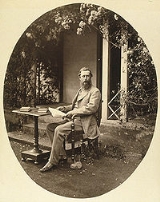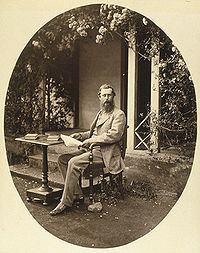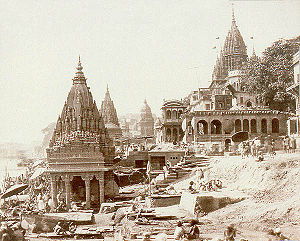
Samuel Bourne
Encyclopedia

Charles Shepherd (photographer)
Charles Shepherd was an English photographer and printer who worked in India in the latter part of the 19th century. In 1862, Shepherd and Arthur Robertson established a photographic studio called Shepherd & Robertson in Agra. The firm moved to Simla in 1864, at which point Samuel Bourne joined...
, he set up Bourne & Shepherd
Bourne & Shepherd
Bourne & Shepherd established in 1863 , is the oldest photographic studio still in operation, and one of the oldest established photographic businesses in the world...
first in Shimla
Shimla
Shimla , formerly known as Simla, is the capital city of Himachal Pradesh. In 1864, Shimla was declared the summer capital of the British Raj in India. A popular tourist destination, Shimla is often referred to as the "Queen of Hills," a term coined by the British...
in 1863 and later in Kolkata
Kolkata
Kolkata , formerly known as Calcutta, is the capital of the Indian state of West Bengal. Located on the east bank of the Hooghly River, it was the commercial capital of East India...
(Calcutta); the company still exists today.
Biography
Samuel Bourne was born into an old farming family, at Arbour Farm, MucklestoneMucklestone
Mucklestone is a small village in Staffordshire, England. It is about nine miles northwest of Eccleshall, and four and a half miles northeast of Market Drayton in Shropshire.It is notable for its associations with the Battle of Blore Heath...
, Shropshire
Shropshire
Shropshire is a county in the West Midlands region of England. For Eurostat purposes, the county is a NUTS 3 region and is one of four counties or unitary districts that comprise the "Shropshire and Staffordshire" NUTS 2 region. It borders Wales to the west...
in 1834. After being educated by a clergyman near Fairburn, he secured a job with Moore and Robinson's Bank, Nottingham in 1855. His amateur photographic activities started at about this time and he quickly became an accomplished landscape photographer, soon lecturing on photography and contributing technical articles to several photographic journals.
In 1858, Bourne made a photographic tour of the Lake District
Lake District
The Lake District, also commonly known as The Lakes or Lakeland, is a mountainous region in North West England. A popular holiday destination, it is famous not only for its lakes and its mountains but also for its associations with the early 19th century poetry and writings of William Wordsworth...
, and in 1859, displayed photographs at the Nottingham Photographic Society's annual exhibition. The following year, his photographs were also shown in London, at the London International Exhibition of 1862. This reception he received motivated him to give up his position at the bank, and set sail for India to work as a professional photographer; arriving in Calcutta early in 1863.

Shimla
Shimla , formerly known as Simla, is the capital city of Himachal Pradesh. In 1864, Shimla was declared the summer capital of the British Raj in India. A popular tourist destination, Shimla is often referred to as the "Queen of Hills," a term coined by the British...
, where they established a new studio ‘Howard & Bourne’, to be joined in 1864 by Charles Shepherd
Charles Shepherd (photographer)
Charles Shepherd was an English photographer and printer who worked in India in the latter part of the 19th century. In 1862, Shepherd and Arthur Robertson established a photographic studio called Shepherd & Robertson in Agra. The firm moved to Simla in 1864, at which point Samuel Bourne joined...
, to form ‘Howard, Bourne & Shepherd’. By 1866, after the departure of Howard, it became ‘Bourne & Shepherd’, which became the premier photographic studio in India, and is still trading in Calcutta today; perhaps the world’s oldest photographic business. Charles Shepherd evidently remained in Simla, to carry out the commercial and portrait studio work, and to supervise the printing and marketing of Bourne’s landscape and architectural studies, whilst Bourne was away travelling around the sub-continent.
Bourne spent six extremely productive years in India, and by the time he returned to England in January 1871, he had made approximately 2,200 fine images of the landscape and architecture of India and the Himalayas
Himalayas
The Himalaya Range or Himalaya Mountains Sanskrit: Devanagari: हिमालय, literally "abode of snow"), usually called the Himalayas or Himalaya for short, is a mountain range in Asia, separating the Indian subcontinent from the Tibetan Plateau...
. Working primarily with a 10x12 inch plate camera, and using the complicated and laborious Wet Plate Collodion process
Collodion process
The collodion process is an early photographic process. It was introduced in the 1850s and by the end of that decade it had almost entirely replaced the first practical photographic process, the daguerreotype. During the 1880s the collodion process, in turn, was largely replaced by gelatin dry...
, the impressive body of work he produced was always of superb technical quality and often of artistic brilliance. His ability to create superb photographs whilst travelling in the remotest areas of the Himalayas and working under the most exacting physical conditions, places him firmly amongst the very finest of nineteenth century travel photographers.
On 29 July 1863, he left Simla on the first of his three major Himalayan photographic expeditions. With a retinue of some 30 porters to carry his equipment, he travelled across the Simla Hills to Chini, in the Valley of the Sutlej River, 160 miles north-east of Simla, and spent some time photographing in the Chini-Sutlej River area, before heading up to the borders of Spiti, and returning to Simla on 12 October 1863, with 147 fine negatives.
In the following year, Bourne set out on another major trip, this time a nine month trip to Kashmir
Kashmir
Kashmir is the northwestern region of the Indian subcontinent. Until the mid-19th century, the term Kashmir geographically denoted only the valley between the Great Himalayas and the Pir Panjal mountain range...
. Leaving Lahore
Lahore
Lahore is the capital of the Pakistani province of Punjab and the second largest city in the country. With a rich and fabulous history dating back to over a thousand years ago, Lahore is no doubt Pakistan's cultural capital. One of the most densely populated cities in the world, Lahore remains a...
on 17 March, he journeyed north-east to Kangra and from there, via Byjnath, Holta, Dharmsala and Dalhousie, to Chamba. From there, he went on to Kashmir, arriving on the borders on 8 June; by the middle of the month had reached the Chenab Valley. The following weeks were spent photographing the scenery of Kashmir before proceeding to Srinagar, where he stopped for some weeks, sight seeing and photographing before continuing his journey on 15 September. The return journey took in the Sind Valley, Baramula, Murree
Murree
Murree city is a popular hill station and a summer resort, especially for the residents of Rawalpindi/Islamabad, and for the cities of the province of Punjab, Pakistan...
, Delhi
Delhi
Delhi , officially National Capital Territory of Delhi , is the largest metropolis by area and the second-largest by population in India, next to Mumbai. It is the eighth largest metropolis in the world by population with 16,753,265 inhabitants in the Territory at the 2011 Census...
and Cawnpore (now Kanpur) before arriving in Lucknow on Christmas Eve 1864.
Bourne's third and last major trip was perhaps his most ambitious; consisting of a six month journey in the Himalayas with the goal of reaching and photographing the source of the Ganges. He left Simla on the 3 July 1866, in the company of Dr. G.R. Playfair (brother of the famous English politician Dr. Lyon Playfair), and travelled with him through Kulu and Lahaul, over the Kunzum Pass into the Spiti valley, where they later parted company. Bourne then continued on alone (except for his forty porters!); over the Manirung Pass, where he took spectacular views of the 18,600 foot high pass; which held the record for the highest altitude photographs that had yet been taken for twenty years. Thence, down to the junction of the Spiti
Spiti
-Geographical locations:*Lahaul and Spiti, a district in the state of Himachal Pradesh in India.*Spiti Valley, former heartland of the former Spiti district now combined.*Spiti River, in the Spiti Valley, Himachal Pradesh.*Spitia River-Language:...
and Sutlej Rivers and on to Sungnam and the Buspa Valley. He then climbed up over the Neela Pass, and down into the Upper Ganges Valley, where he journeyed on up to the Gangotri Glacier
Gangotri Glacier
Gangotri Glacier is located in Uttarkashi District, Uttarakhand, India in a region bordering China. This glacier, source of the Ganges, is one of the largest in the Himalayas with an estimated volume of over 27 cubic kilometers. The glacier is about 30 kilometres long and 2 to 4 km wide...
. There he went on to photograph one of the prime sources of the Ganges, as it issued from the mouth of the glacial ice cave at Gaumukh. His return journey took in Agra
Agra
Agra a.k.a. Akbarabad is a city on the banks of the river Yamuna in the northern state of Uttar Pradesh, India, west of state capital, Lucknow and south from national capital New Delhi. With a population of 1,686,976 , it is one of the most populous cities in Uttar Pradesh and the 19th most...
, Mussoorie
Mussoorie
Mussoorie is a city and a municipal board in the Dehradun District of the northern Indian state of Uttarakhand. It is located about 35 km from the state capital of Dehradun and 290 km north from the national capital of New Delhi...
, Roorkee
Roorkee
Roorkee is a city and seat of a municipal council in Uttarakhand, in far northern India. It is located on the banks of the Ganges canal on the national highway between Delhi and Dehradun. Roorkee is known for Roorkee Cantonment, one of the country's oldest cantonments, and the headquarters of...
, Meerut and Naini Tal, and he arrived back in Simla
Shimla
Shimla , formerly known as Simla, is the capital city of Himachal Pradesh. In 1864, Shimla was declared the summer capital of the British Raj in India. A popular tourist destination, Shimla is often referred to as the "Queen of Hills," a term coined by the British...
, again in time for Christmas! He wrote extensively about his travels in the Himalayas (one of the very few photographers in India to do so), in a long series of letters, which appeared in The British Journal of Photography, between 1863 and 1870.
The studio business prospered, and in 1866, they opened a second branch in Calcutta, where they ran a portrait studio, and their work was widely retailed throughout the subcontinent by agents and in Britain through wholesale distributors. In 1867 he went briefly back to England, in order to marry Mary Tolley, daughter of a wealthy Nottingham businessman; and they both returned to India again later that year, where he continued to travel around the country, producing some 500 more fine images. He departed Bombay for England permanently in November 1870. His work as travelling landscape and architectural photographer for Bourne & Shepherd studios was taken over by Colin Murray, who continued taking fine images of India, in a very similar style, and later went on to take over the management of the business.
Some time shortly after his return to England, he sold off his interests in Bourne and Shepherd studios, and from then on, had nothing more to do with commercial photography; however his archive of some 2,200 glass plate negatives remained with the studio, and were constantly re-printed and sold over the following 140 years, until their eventual destruction in a Calcutta fire on February 6, 1991.
Back in England
Bourne settled back in Nottingham, where he founded a cotton-doubling business, in partnership with his brother-in-law J.B. Tolley. The business prospered, and Bourne become a local magistrate. Although continuing to photograph as a relaxation, and belonging to the local Photographic Society, much of his creative energy from this time onwards was devoted to water-colour painting. He died in Nottingham on 24 April 1912.Bourne is justly regarded as one of the finest landscape and travel photographers of 19th century India; combining a fine eye for composition with high technical expertise.

